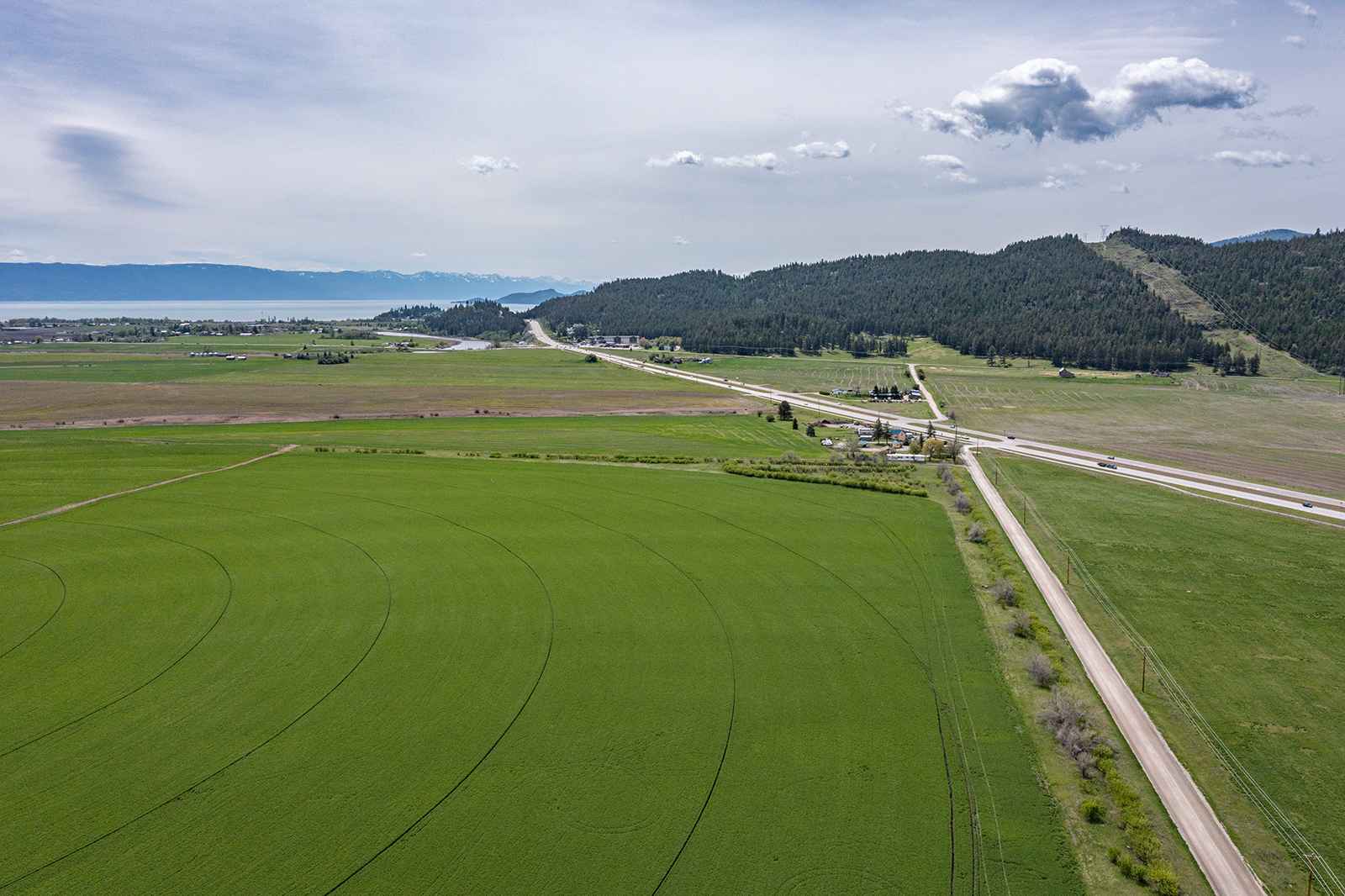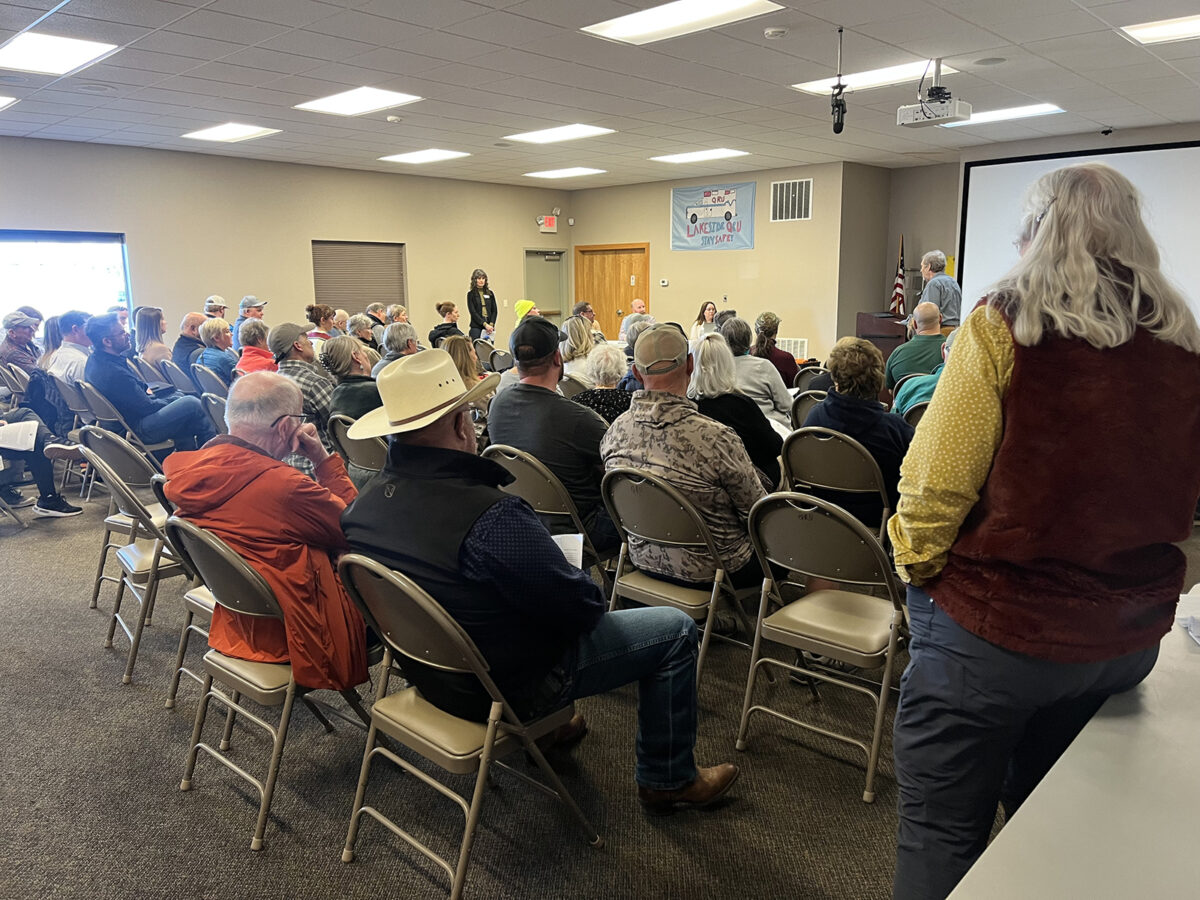Community Members Divided Over Wastewater Treatment Expansion as DEQ Officials Weigh Permit Decision
The state agency held a public hearing on Thursday, the last day of the twice-extended public comment period. Proponents highlighted the permit’s stringent regulations in comparison to current county practices, while opponents warned against shortcomings in the permit’s design.
By Zoë Buhrmaster
Around 70 people crowded into a community room in Lakeside late Thursday afternoon for the Montana Department of Environmental Quality’s (DEQ) public hearing on a permit that would allow a local sewer district to discharge treated wastewater into the groundwater near Flathead Lake.
DEQ officials scheduled the Feb. 27 hearing after receiving more than 200 public comments about a permit the agency is reviewing that would allow the discharge of treated wastewater into the groundwater two miles north of Flathead Lake, where the Lakeside County Water and Sewer District’s (LCWSD) 40-year-old wastewater facility is located off Wiley Dike Road.
The LCWSD is seeking a Montana Ground Water Pollution Control System permit to implement phase one of a two-part plan to ultimately build a septage receiving facility for Flathead County, as well as a new wastewater treatment facility for Lakeside. The expanded system would use rapid infiltration basins (RIBs) to increase the facility’s treatment capacity to 200,000 gallons per day (gpd) of effluent, with the potential to eventually treat 900,000 gpd — an expansion that opponents and proponents both agreed was necessary as the region grapples with unprecedented growth.
As the public hearing got underway Thursday, however, the divide over the facility’s location was evident in the seating arrangement, which was split evenly on either side of the aisle with proponents of the draft groundwater permit on one side and opponents on the other.
Flathead Lake homeowners, Lakeside residents, and members of local watchdog groups, including the Citizens for a Better Flathead (CBF) and the North Shore Water Alliance (NSWA), voiced concerns over the proposed facility’s proximity to Flathead Lake, with opponents citing peer-reviewed studies that CBF independently commissioned to examine the DEQ’s environmental assessment. The studies, they said, revealed shortcomings in the permit’s design.
Lakeside resident Bruce Young, a former member of the Lakeside committee who originally helped select the site for the district’s sewer and water facility, pointed out that the committee had been aware of the property’s limitations “because of a high groundwater table, because of its proximity to the Flathead River and to the [Somers Plant] Superfund site, which was the Burlington Northern cleanup site, one mile to the south.”
“I think we’re all for doing this, but the devil’s in the details,” Young said. “And the details are in the location.”
Representatives from Columbia Falls, Whitefish Public Works, the LCWSD, all three Flathead County Commissioners, and residents with backgrounds in wastewater treatment and civil engineering agreed on the desperate need for better wastewater treatment, citing the county’s current method of spraying sewage onto fields around the Lower Valley that can get into surface waters untreated.

Several pointed out that cities such as Bigfork and Kalispell already discharge treated wastewater into bodies of water such as Ashley Creek, and that the permit under DEQ review requires more stringent treatment to reduce nitrogen and phosphorous by 80%.
Evergreen Water and Sewer District General Manager Cindy Murray said Evergreen is another example of the dire need for an expanded county septage facility as the district has resorted to private pumping companies that have raised customer costs by over 250% since 2022.
“Part of the way we’ve been dealing with this is to postpone some of our pumping such that by July of this year on our pumping schedule, which is we try to pump all our tanks on a six-year schedule, we will be behind almost 600 tanks,” Murray said.
In two peer-review studies CBF commissioned to analyze the DEQ’s environmental assessment of the permit, engineering firm HydroSolutions and Hauer Environmental LLC described issues with the agency’s testing requirements. Specifically, HydroSolutions stated that the “slug tests” relied on by engineering firm Water and Environmental Technologies (WET) for the site’s hydrogeologic assessment were less reliable than pumping tests, based on a 1991 study comparing the two.
Hauer Environmental also reports that the proposed permit misidentified the aquifer on the project site “as a homogeneous shallow sand layer,” when it is instead “highly heterogeneous and may have many preferential flow pathways,” the report states, citing previous studies and satellite imagery.
“Thus, the receiving delta aquifer is poorly suited for nutrient pollutant assimilation, especially phosphorus or nitrogenous pollutants,” the report states. “Our conclusions here agree with the report findings of HydroSolutions Inc. that the wastewaters may appear within weeks and perhaps even days in surrounding surface waters rather than the Montana DEQ Permit application estimated time frame of years to decades.”
Public comments sent to the DEQ prior to the meeting included a letter from the Confederated Salish and Kootenai Tribes (CSKT), the nonprofit Flathead Lakers, former Flathead Basin Commission chair Thompson Smith, and other concerned community members from around the valley.
The CSKT’s four-page letter includes reference to the CBF-commissioned study, and requests that the agency consult with CSKT due to the permit’s “direct tribal implications” as it could affect waters tribal members rely on for “subsistence, medicinal, spiritual, and other cultural needs.”
Flathead Lakers raised concerns about soils in the area, recommending another site-specific hydrogeologic study and permeability analysis, along with evaluating and publicly disclosing other alternative sites with “deeper groundwater and better soil filtration,” as the DEQ documents do not provide a comparative analysis of other sites. They note that the permit should require PFAS testing in groundwater monitoring.

The DEQ did not respond to any comments during the public meeting. In an interview with the Beacon last week, DEQ Water Protection Bureau Chief Tatiana Davila said that they are reviewing them as they come in.
“That’s definitely one that we’re looking at to see if changes need to be made to the permit or if we need to take another look at it,” Davila said regarding the two engineering firms’ analyses.
The rapid infiltration basins, or RIBs, that would be used in Lakeside’s expansion project are not new to Montana. The DEQ has permitted RIBs at Belgrade and other communities, DEQ Engineering Bureau Chief Rachel Clark said.
“I can say that this is highly treated wastewater, before it goes to the rapid infiltration basin,” Clark said. “I’m not aware of any problems that we have had in the state with those few that are authorized.”
The permit requires that a DEQ compliance officer visits the facility monthly to ensure that the nitrogen and phosphorus effluent levels are within the permitted limitations. If a facility goes out of compliance, the DEQ will usually work with them to get them back into compliance before pulling a permit, Davila said, noting that such incidents are often one-time exceptions.
“If you had a permit team that had just consistent exceedances, weren’t coming back into compliance, weren’t taking the steps to rectify the issue, then that’s when we would be looking at next steps in terms of taking a route to enforcement or even potentially revoking the permit,” Davila said.
In response to questions about the technology in the second phase of the plan that will be responsible for treating the wastewater, an email from the DEQ on Friday stated that the current permit under review is to determine the treated wastewater quality necessary to minimize impacts to ground and surface water in the area.
“Lakeside is currently considering wastewater treatment process upgrades that would be capable of meeting the high treatment levels required in the permit,” the email stated. “A sequencing batch reactor (SBR) is one of several potential advanced biological nutrient removal wastewater treatment systems being considered for future upgrades. Once a treatment system is selected by the district, DEQ will review that system against the state’s design standards.”
“DEQ will not approve a treatment system unless it can be shown through modeling and comparable system performance that it can meet the final wastewater quality required in the discharge permit,” the DEQ stated.
Despite the division at the meeting, proponents and opponents alike noted the validity of concerns voiced on both sides. Lakeside resident and former Montana House representative Tanner Smith noted the shared passion for the lake and its importance to the valley.
“We are all personally invested in keeping this place clean. You’re in a tough spot,” Smith said, nodding to the board of DEQ representatives, “because everybody you heard from today is correct. They all have a certain amount of correctness to their topics. But I am a proponent for this, because we do need to grow.”
The public comment period closed at midnight on Thursday, Feb. 27, following the public hearing. Davila thanked those who spoke and provided written comments for their contribution at the meeting, noting that the DEQ will take them into consideration and “respond to all substantive comments” before issuing a final decision on the permit within sixty days.”